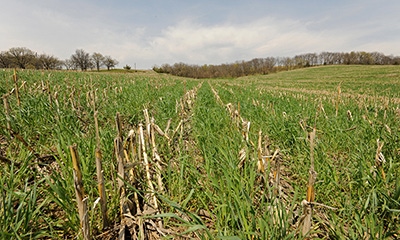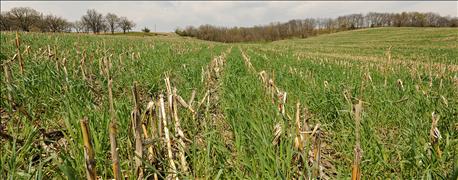February 28, 2016

Editor’s note: Jason Johnson is public affairs specialist with USDA’s Natural Resources Conservation Service in Des Moines.
Iowa farmers planted an estimated 500,000 cover crop acres last year, and although that record number is expected to increase in 2016, many of those farmers struggle to find a foolproof way to get consistent cover crop establishment.
Lack of rainfall and cool temperatures are cover crop growth obstacles which can’t be controlled. But one thing that can be controlled is choosing the right herbicide this spring for corn and soybeans to reduce potentially injuring cover crops which are seeded in the fall.

CHOOSE THE RIGHT HERBICIDE: Interest in planting cover crops has increased due to benefits they provide to a corn-soybean cropping system. Use of residual herbicides has increased at the same time, and the potential impact these herbicides may have on establishing cover crops is an important consideration.
“What herbicide you choose to use this spring for your corn and soybean crops will definitely have an effect on success with cover crops in the fall,” says Barb Stewart, state agronomist with USDA’s Natural Resources Conservation Service in Des Moines. “In most cases there is a short time period between cover crop planting date and the onset of cooler fall temperatures, which increases the risk that herbicides pose to cover crops.”
According to a new Iowa State University report, titled “Effect of Residual Herbicides on Cover Crop Establishment” which was written by ISU Extension weed specialist Bob Hartzler and ISU field agronomist Meaghan Anderson, the threat posed by herbicide to cover crop establishment is determined by:
•the chemical’s half-life and availability in the soil,
•sensitivity of cover crop species,
•herbicide application rate and date, and
•environmental conditions throughout the growing season.
Hartzler and Anderson conducted greenhouse experiments on five cover crop species, evaluating several herbicides commonly used in Iowa corn and soybean production. Radishes tended to be the most sensitive cover crop evaluated, while cereal rye was the most tolerant to herbicides. The new publication by Hartzler and Anderson was released February 20, 2016.
Be careful if you plan to graze livestock on cover crops
Do you plan to graze your cover crop this coming fall? Barb Stewart, the Iowa NRCS state agronomist, offers another caution for farmers to think about regarding cover crops and herbicides. She says livestock producers who use cover crops for livestock forage should consider the grazing restrictions that are explained on labels of herbicides which are applied earlier in the growing season.
An Iowa State University publication titled “Herbicide Use May Restrict Grazing Options for Cover Crops” includes tables listing herbicide products that allow the establishment of cover crops for grazing or forage harvest during the same cropping season as the herbicide application. The ISU publication number is CROP 3082, and it was published in December 2015.
For more information about herbicide use and cover crops, refer to:
•“Effect of Residual Herbicides on Cover Crop Establishment,” Iowa State University Extension
• “Herbicide Use May Restrict Grazing Options for Cover Crops,” Iowa State University Extension
• “Herbicide Rotation Restrictions in Forage and Cover Crop Cropping Systems,” University of Wisconsin Extension
You May Also Like




